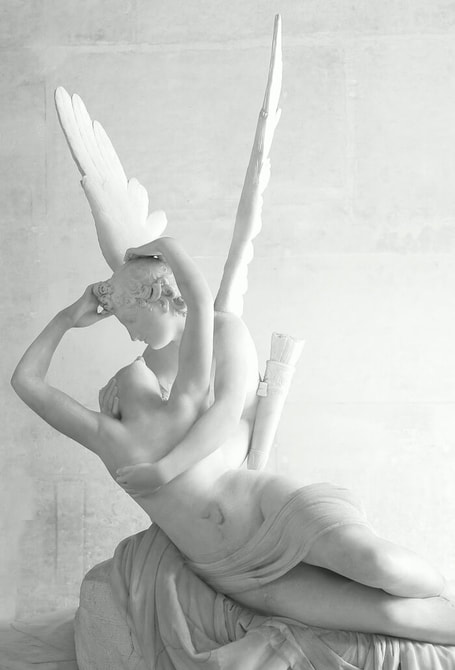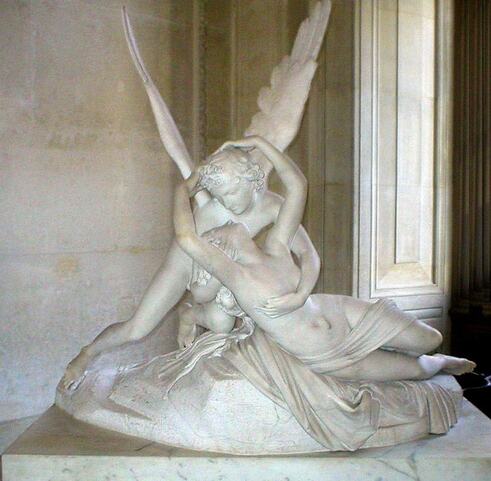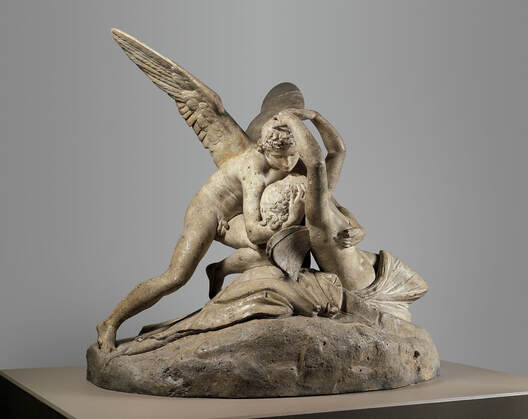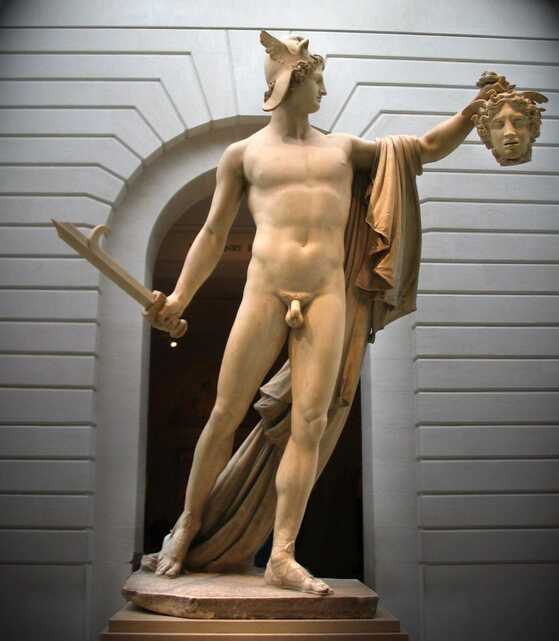|
Where? Ground floor, room 403 of the Denon wing in the Louvre
When? 1787-1793 Commissioned by? Colonel John Campbell What do you see? The moment at which the lifeless body of Psyche is just brought back to life by Cupid. The figures of Cupid and Psyche (except the wings) are positioned in a pyramid shape, which creates a stable form for the sculpture. Cupid sits on one knee on top of a rock and holds Psyche by her head and breast. He has large wings pointing straight up into the air and wears his arrows in a quiver on his back. Psyche reaches up to Cupid and has her hands on his head. She lets her head hang back and they are about to kiss. Her long hair reaches all the way to the ground. She has a cloth wrapped around her lower body. Behind them lays the flask with the ointment that Psyche had collected from the underworld. Directly to the right of the flask is Cupid's arrow, which he used to wake up Psyche. This story symbolizes the big efforts and challenges a human must undergo to achieve happiness and immortality. Look also at the precision with which Canova created the smooth bodies of Cupid and Psyche. This smoothness contrasts nicely with the wrinkly texture of the sheet wrapped around Psyche and the rougher texture of the rock on which they sit. Near the right foot of Psyche is a handle, which was originally included to turn the sculpture around as it was worth seeing this sculpture from all possible angles.
Backstory: This sculpture is based on a story the Roman writer Apuleius wrote in his book Metamorphoses, chapters four, five, and six (you can download the book here for free). In short, Psyche was considered the most beautiful woman alive, and Cupid fell in love with her. The painting Cupid and Psyche in the Cleveland Museum of Art by Jacques-Louis David shows the couple after they made love.
The goddess Venus was jealous of Psyche's beauty and sent her on a very dangerous journey to the underworld to collect a flask with Proserpina’s beauty ointment. Psyche succeeds with the help of Cupid. Venus instructed Psyche not to open the flask, but after she completes the journey, she could not resist and opened it to take some of the content. But instead of becoming more beautiful, the ointment makes her fall in a very deep sleep as Proserpina had filled the flask with sleep of the innermost darkness. Cupid forgives Psyche and revives her. He asks for the help of Zeus who makes Psyche immortal. Cupid and Psyche marry and stay together forever. Multiple Versions: Antonio Canova created another version of this statue for the Russian art collector Prince Yusupov. This version was made in 1796 and is now in the Hermitage Museum in Saint Petersburg. It differs somewhat from the current version as Yusupov asked for some changes. For example, he wanted the cloth on Psyche to cover her legs completely. The favorite student of Canova, Adamo Tadolino, inherited the plaster model for this sculpture, which is now at the Metropolitan Museum of Art. He used this model to create at least five known marble replicas of this sculpture with small modifications. He added, for example, small butterfly wings to the back of Psyche and created smaller wings for Cupid.
Who is Psyche? One of the three daughters of an unknown king and queen. She was very beautiful, and people treated her like a goddess. Venus was jealous of her beauty and the way she was treated. She asked her son Cupid to use his arrows to make her marry the ugliest of all human beings. However, when Cupid saw Psyche, he fell in love with her.
Psyche's father went to an oracle to ask why her daughter had not married yet. The oracle said that Psyche should be left behind there immediately as otherwise terrible disasters would happen. Next, the god Zephyr blew her away and put her in a palace by herself. There, every night she made love to a person that she was not allowed to see. This person was Cupid. When she discovered this, Cupid fled. To get him back, Psyche followed the instructions of Venus to gather a beauty ointment from the underworld as described above. Who is Canova? Antonio Canova (1757-1822) was born in Possagno, a small town in the Northeast of Italy. He studied arts in Venice and then moved to Rome at age 23 to start his own workshop. He completed various commissions for the Pope while in Rome. In 1802, he moved to Paris where he created several sculptures for Napoleon. He was inspired by the ancient Greek and Roman sculptures. He revived this classical style and Canova is considered to be the prime Neoclassical sculptor. His sculptures are praised because of their perfect form and finish. The careful finish of the human bodies makes his statues look like real flesh and makes them come alive. An example of another great sculpture of Canova is Perseus with the Head of Medusa in the Vatican Museums. A replica of this statue can be found in the Metropolitan Museum of Art.
Fun fact: Canova conducted extensive research to create this sculpture. The position of Cupid is copied exactly from a painting he saw in Herculaneum near Naples. After many sketches, he then created numerous clay figures of the sculpture. Unlike many other sculptors who created small-sized clay models for a sculpture, Canova created the clay models at their real size. This helped him to accurately sculpt his work in marble.
Note that the flask and the wings of Cupid are sculpted separately and are inserted into the rest of the sculpture. For example, you can still see some marks on where the wings are attached to Cupid’s back. Finally, Canova had special curved chisel tools designed for him, which he used to carve out the sculpture’s most inaccessible places. This attention to detail makes him one of the most admired sculptors in history.
Written by Eelco Kappe
0 Comments
Leave a Reply. |
Categories
All
|
- Home
- Blog
-
Museums
- Alte Pinakothek
- Art Institute of Chicago
- Baltimore Museum of Art
- Barber Institute of Fine Arts
- Bargello
- Barnes Foundation
- British Museum
- Church of Sant’Anastasia
- Cleveland Museum of Art
- Courtauld Institute of Art
- Detroit Institute of Arts
- Frans Hals Museum
- Galleria Borghese
- Gallerie dell'Accademia
- Getty Museum
- Guggenheim
- Hermitage Museum
- Kunsthistorisches Museum
- Kunstmuseum Basel
- Legion of Honor Museum
- Louvre
- Mauritshuis
- Metropolitan Museum of Art
- Musee d’Orsay
- Museum of Fine Arts in Boston
- Museum of Modern Art
- National Gallery in London
- National Gallery of Art
- National Museum in Poznań
- Norton Simon Museum
- Ny Carlsberg Glyptotek
- Palace of Versailles
- Palazzo Pitti
- Palazzo Vecchio
- Petit Palais
- Philadelphia Museum of Art
- Prado
- Pushkin Museum
- Ravenna Art Museum
- Rijksmuseum
- San Diego Museum of Art
- Santa Maria delle Grazie
- St. Peter's Basilica
- Städel Museum
- Statens Museum for Kunst
- Tate Britain
- Tate Modern
- Timken Museum of Art
- Uffizi
- Vatican Museums
- Wallace Collection
-
Artists
- Altdorfer
- Anguissola
- Berlin Painter
- Bosch
- Botticelli
- Boucher
- Bronzino
- Bruegel the Elder
- Brunelleschi
- Cabanel
- Caillebotte
- Canova
- Caravaggio
- Carpeaux
- Cezanne
- Cimabue
- David
- Degas
- Delacroix
- De Maria
- Donatello
- El Greco
- Fontana
- Fra Angelico
- Fragonard
- Gauguin
- Gentileschi
- Gericault
- Gonzalez-Torres
- Goya
- Hals
- Hogarth
- Hokusai
- Ingres
- Leonardo da Vinci
- Lippi, Filippo
- Longhi, Barbara
- Lorrain
- Makovsky
- Manet
- Massys
- Matisse
- Merian
- Michelangelo
- Mochi
- Modigliani
- Monet
- Panini
- Parmigianino
- Perugino
- Picasso
- Pisanello
- Raphael
- Rembrandt
- Renoir
- Reynolds
- Rivera
- Rodin
- Rubens
- Scultori
- Seurat
- Steen
- Tintoretto
- Titian
- Toulouse-Lautrec
- Turner
- Uccello
- Van der Weyden
- Van Dyck
- Van Eyck
- Van Gogh
- Van Hemessen
- Vasari
- Velazquez
- Vermeer
- Veronese
- Vigée Le Brun
-
Locations
- Books
- About Us




